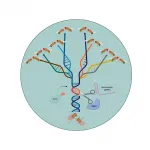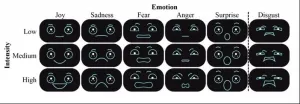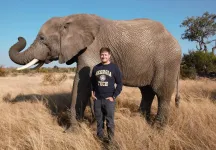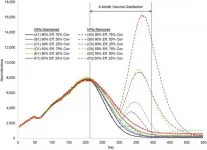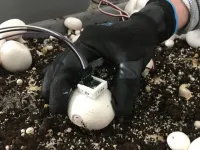(Press-News.org) CRISPR-based technologies offer enormous potential to benefit human health and safety, from disease eradication to fortified food supplies. As one example, CRISPR-based gene drives, which are engineered to spread specific traits through targeted populations, are being developed to stop the transmission of devastating diseases such as malaria and dengue fever.
But many scientists and ethicists have raised concerns over the unchecked spread of gene drives. Once deployed in the wild, how can scientists prevent gene drives from uncontrollably spreading across populations like wildfire?
Now, scientists at the University of California San Diego and their colleagues have developed a gene drive with a built-in genetic barrier that is designed to keep the drive under control. Led by molecular geneticist Omar Akbari's lab, the researchers engineered synthetic fly species that, upon release in sufficient numbers, act as gene drives that can spread locally and be reversed if desired.
The scientists describe their SPECIES (Synthetic Postzygotic barriers Exploiting CRISPR-based Incompatibilities for Engineering Species) development as a proof-of-concept innovation that could be portable to other species such as insect disease vectors. Spreading gene drives that limit pests that feast on valuable food crops is another example of a potential SPECIES application.
"Gene drives can potentially spread beyond intended borders and be hard to control. SPECIES offers a way to control populations in a very safe and reversible manner," said Akbari, a UC San Diego Division of Biological Sciences associate professor and senior author of the paper, which is published in the journal Nature Communications.
The idea behind the creation of SPECIES is reflective of the formation of new species in nature. As members of a single species separate over time, due to, for example, a new land formation, earthquake separation or other geological event, a new species eventually can evolve from the physical disconnection. If the new species eventually returns to mate with the original species, they could produce unviable offspring due to biological changes following the separation through a natural phenomenon known as reproductive isolation.
Working in the fly species Drosophila melanogaster, UC San Diego researchers and their colleagues at the California Institute of Technology, UC Berkeley and the Innovative Genomics Institute used CRISPR genetic-editing technologies to develop flies encoding SPECIES systems that are reproductively incompatible with wild versions of D. melanogaster.
"Even though speciation happens consistently in nature, creating a new artificial species is actually a pretty big bioengineering challenge," said Anna Buchman, the lead author of the paper. "The beauty of the SPECIES approach is that it simplifies the process, giving us a defined set of tools we need in any organism to elegantly bring about speciation."
Conceptually, when SPECIES are deployed in the wild in sufficient numbers, they can controllably drive through a population and replace all of their wild counterparts as they spread. Using malaria as an example, SPECIES mosquitoes could be developed with a genetic element that makes them incapable of transmitting malaria.
"You can spread an anti-malaria SPECIES into a target population in a confinable and controllable way," said Akbari. "Since SPECIES are incompatible with wild-type mosquitoes, their populations can be controlled and reversed by limiting their threshold population below 50 percent. This gives you the ability to confine and reverse its spread if desired."
As the SPECIES barrier completes its role in temporarily replacing wildtype populations, their numbers can be reduced with the reintroduction of wild type populations.
"This essentially allows us to harness all of the power of gene drives--like disease elimination or crop protection--without the high risk of uncontrollable spread," said Akbari.
INFORMATION:
INFORMATION:
Coauthors of the paper include Anna Buchman, Isaiah Shriner (former UC San Diego undergraduate student), Ting Yang, Junru Liu (current Biological Sciences PhD student), Igor Antoshechkin, John Marshall, Michael Perry and Omar Akbari.
CHICAGO -- Women who experience acute aortic dissection--a spontaneous and catastrophic tear in one of the body's main arteries--not only are older and have more advanced disease than men when they seek medical care, but they also are more likely to die, according to research published online today in The Annals of Thoracic Surgery.
"Data over the course of the last few decades demonstrate differences in both presentation and outcomes between males and females who have acute aortic dissection, with greater mortality among females," said Thomas G. Gleason, MD, from Brigham and Women's Hospital in Boston, Massachusetts. "This study underscores ...
Can you trust the map on your smartphone, or the satellite image on your computer screen?
So far, yes, but it may only be a matter of time until the growing problem of "deep fakes" converges with geographical information science (GIS). Researchers such as Associate Professor of Geography Chengbin Deng are doing what they can to get ahead of the problem.
Deng and four colleagues -- Bo Zhao and Yifan Sun at the University of Washington, and Shaozeng Zhang and Chunxue Xu at Oregon State University -- co-authored a recent article in Cartography and Geographic Information Science that explores the problem. In "Deep ...
Popcorn. What would movies and sporting events without this salty, buttery snack? America's love for this snack goes beyond these events. We consume 15 billion quarts of popped popcorn each year.
When it comes to popcorn, consumers want a seed-to-snack treat that leaves more snacks than seeds when popped. This means when they pop the corn, there shouldn't be many unpopped kernels left in the bowl.
Maria Fernanda Maioli set out to determine the properties affecting popping expansion in popcorn. The team's research was recently published in Agronomy Journal, a publication of the American Society of Agronomy.
"The way kernels expand is a basic, ...
BEER-SHEVA, Israel...June 2, 2021 - As drones become more ubiquitous in public spaces, researchers at Ben-Gurion University of the Negev (BGU) have conducted the first studies examining how people respond to various emotional facial expressions depicted on a drone, with the goal of fostering greater social acceptance of these flying robots.
The research, which was presented recently at the virtual ACM Conference on Human Factors in Computing Systems, reveals how people react to common facial expressions superimposed on drones.
"There is a lack of research on how drones are perceived and understood by humans, which is vastly different than ground robots." says Prof. Jessica Cauchard together with Viviane Herdel of BGU's Magic Lab, in the BGU Department of Industrial ...
New research from the Georgia Institute of Technology finds that elephants dilate their nostrils in order to create more space in their trunks, allowing them to store up to nine liters of water. They can also suck up three liters per second -- a speed 50 times faster than a human sneeze (150 meters per second/330 mph).
The Georgia Tech College of Engineering study sought to better understand the physics of how elephants use their trunks to move and manipulate air, water, food and other objects. They also sought to learn if the mechanics could inspire the creation of more efficient robots that use air motion to hold and move things.
While octopus use jets of water to move and archer fish shoot water above the surface to catch insects, the Georgia Tech researchers found that elephants ...
Boulder, Colo., USA: Article topics include Zealandia, Earth's newly recognized continent; the topography of Scandinavia; an interfacial energy penalty; major disruptions in North Atlantic circulation; the Great Bahama Bank; Pityusa Patera, Mars; the end-Permian extinction; and Tongariro and Ruapehu volcanoes, New Zealand. These Geology articles are online at https://geology.geoscienceworld.org/content/early/recent.
Mass balance controls on sediment scour and bedrock erosion in waterfall plunge pools
Joel S. Scheingross; Michael P. Lamb
Abstract: Waterfall plunge pools experience cycles of sediment aggradation and scour that modulate ...
CHAPEL HILL, NC - Research published by JAMA Network Open shows how non-pharmaceutical interventions (NPIs) like mask wearing and physical distancing can help prevent spikes in COVID-19 cases as populations continue to get vaccinated. The study, led by Mehul Patel, PhD, a clinical and population health researcher in the department of Emergency Medicine at the UNC School of Medicine, focuses on the state of North Carolina. Similar modeling studies have been used in different states, and can serve as guidance to leaders as they make decisions to relax restrictions and safety protocols.
"The computer simulation modeling allows us to look at multiple factors that play a role in decreasing the spread of COVID-19 as vaccines are ...
PROVIDENCE, R.I. [Brown University] -- By delivering small electrical pulses directly to the brain, deep brain stimulation (DBS) can ease tremors associated with Parkinson's disease or help relieve chronic pain. The technique works well for many patients, but researchers would like to make DBS devices that are a little smarter by adding the capability to sense activity in the brain and adapt stimulation accordingly.
Now, a new algorithm developed by Brown University bioengineers could be an important step toward such adaptive DBS. The algorithm removes a key hurdle that makes it difficult for DBS systems to sense brain signals while simultaneously delivering stimulation.
"We know that there are electrical signals ...
Researchers in Penn State's College of Agricultural Sciences have developed a robotic mechanism for mushroom picking and trimming and demonstrated its effectiveness for the automated harvesting of button mushrooms.
In a new study, the prototype, which is designed to be integrated with a machine vision system, showed that it is capable of both picking and trimming mushrooms growing in a shelf system.
The research is consequential, according to lead author Long He, assistant professor of agricultural and biological engineering, because the mushroom industry has been facing labor shortages and rising labor costs. Mechanical or robotic picking can help alleviate those problems.
"The mushroom industry in Pennsylvania is producing about two-thirds of the mushrooms ...
Older adults with cognitive impairment are two to three times more likely to fall compared with those without cognitive impairment. What's more, the increasing use of pain medications for chronic pain by older adults adds to their falls risk. Risks associated with falls include minor bruising to more serious hip fractures, broken bones and even head injuries. With falls a leading cause of injury for people aged 65 and older, it is an important public health issue to study in order to allow these adults increased safety and independence as they age.
Although elevated risk of falls due to use of pain medication by older adults has been widely studied, less ...
